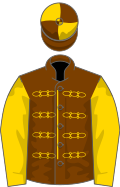| Class | Group 2 |
|---|---|
| Location | Haydock Park Haydock, England |
| Inaugurated | 1939 |
| Race type | Flat / Thoroughbred |
| Sponsor | Bet365 |
| Website | Haydock Park |
| Race information | |
| Distance | 1m 3f 175y (2,373 m) |
| Surface | Turf |
| Track | Left-handed |
| Qualification | Three-years-old and up fillies & mares |
| Weight | 8 st 9 lb (3yo); 9 st 7 lb (4yo+) Penalties 5 lb for Group 1 winners * 3 lb for Group 2 winners * * after 2024 |
| Purse | £125,000 (2025) 1st: £70,888 |
| 2025 | ||
 |  |  |
| Estrange | Scenic | Love Talk |
| Previous years | ||
|---|---|---|
| 2024 | ||
 |  |  |
| Queen Of The Pride | Tiffany | Lady Boba |
| 2023 | ||
 |  |  |
| Poptronic | Sea Silk Road | Mimikyu |
| 2022 | ||
 |  |  |
| Free Wind | Sea La Rosa | Eshaada |
| 2021 | ||
 |  |  |
| Alpinista | Lady Hayes | Cabaletta |
| 1990-1988 | ||
|---|---|---|
| 1990 | ||
 |  |  |
| Pharian | Cruising Height | Ivrea |
| 1989 | ||
 |  |  |
| Roseate Tern | Lucky Song | Wrapping |
| 1988 | ||
 |  |  |
| Andaleeb | Dutchess Best | Bourbon Topsy |
The Lancashire Oaks is a Group 2 flat horse race in Great Britain open to fillies and mares aged three years or older. It is run at Haydock Park over a distance of 1 mile, 3 furlongs and 175 yards (2,373 metres), and it is scheduled to take place each year in early July.
































































